Quirinal Palace
The Quirinal Palace (Italian: Palazzo del Quirinale [paˈlattso del kwiriˈnaːle]) is a historic building in Rome, Italy, one of the three current official residences of the President of the Italian Republic, together with Villa Rosebery in Naples and the Tenuta di Castelporziano, an estate on the outskirts of Rome, some 25 km from the centre of the city. It is located on the Quirinal Hill, the highest of the seven hills of Rome in an area colloquially called Monte Cavallo. It has served as the residence for thirty Popes, four Kings of Italy and twelve Presidents of the Italian Republic.
| Quirinal Palace | |
|---|---|
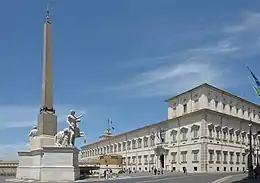 The palace seen from Piazza del Quirinale | |

| |
| General information | |
| Town or city | Rome |
| Country | Italy |
| Completed | 1583 |
| Client | Pope Gregory XIII |
| Design and construction | |
| Architect | Domenico Fontana Carlo Maderno |
The Quirinal Palace was selected by Napoleon to be his residence par excellence as Emperor.[1] However, he never stayed there because of the French defeat in 1814 and the subsequent European Restoration.[2]
The palace extends for an area of 110,500 square metres and is the eleventh-largest palace in the world in terms of area,[3] some twenty times the area of the White House.
History
Origins
The current site of the palace has been in use since Roman times, as excavations in the gardens testify. On this hill, the Romans built temples to several deities, from Flora to Quirinus, after whom the hill was named. During the reign of Constantine the last complex of Roman baths was built here, as the statues of the twins Castor and Pollux taming the horses decorating the fountain in the square testify. The Quirinal, being the highest hill in Rome, was much sought after and became a popular location for the Roman patricians, who built luxurious villas there. An example of those are the remains of a villa in the Quirinal gardens, where a mosaic, part of the old floor has been found.
Foundation of the current palace
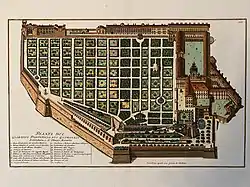
The palace, located on the Via del Quirinale and facing onto the Piazza del Quirinale, was built in 1583 by Pope Gregory XIII as a papal summer residence. The pope, who wanted to find a location which was far away from the humidity and stench coming from the river Tiber and likewise the unhealthy conditions of the Lateran Palace, chose the Quirinal hill as it was one of the most suitable places in Rome. On the site, there was already a small villa owned by the Carafa family and rented to Luigi d'Este. The pope commissioned the architect Ottaviano Mascherino to build a palace with porticoed parallel wings and an internal courtyard by incorporating the Carafa villa, the original nucleus of the palace, later known as the gregorian building. That project was not fully completed due to the death of the pope in 1585 but it is still recognisable in the north part of the courtyard, especially in the double loggia facade, topped by the panoramic Torre dei Venti (tower of the winds) or Torrino. To the latter, a bell tower was added according to a project by Carlo Maderno and Francesco Borromini.
From the 17th century
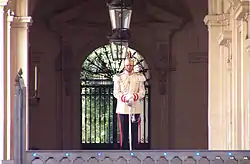

Pope Paul V (r. 1605–1621) commissioned the completion of the work on the main building of the palace.
The Palace was also used as the location for papal conclaves in 1823, 1829, 1831, and 1846. It served as a papal residence and housed the central offices responsible for the civil government of the Papal States until 1870. In September 1870, what was left of the Papal States was occupied militarily and annexed to the Kingdom of Italy. Some five months later, in 1871, Rome became the capital of the new Italian state. The palace became the official royal residence of the Kings of Italy, though some of these, notably King Victor Emmanuel III (reigned 1900–1946) actually lived in a private residence elsewhere (Villa Savoia), leaving the Quirinal to be used simply as a suite of offices and for state functions. The monarchy was abolished in 1946 and the Palace became the official residence and workplace for the Presidents of the Italian Republic. Still, some have declined the Colle residence and kept their usual Roman residence: for example, Sandro Pertini preferred his old flat near the Trevi Fountain.
The Palace's façade was designed by Domenico Fontana. Its Great Chapel was designed by Carlo Maderno. It contains frescos by Guido Reni, but the most famous fresco is the Blessing Christ by Melozzo da Forlì, placed over the stairs. The Palace grounds include a famous set of gardens laid out in the 17th century.[4]
Art
Interiors
The palace is composed of the main building, which is built around the majestic courtyard, with the most beautiful halls and rooms of the complex environments that serve as representative of the Presidency of the Republic, while the offices and apartments of the head of state are housed in the Fuga building at the end of the Manica lunga, the long building on the side of Quirinal street (via del Quirinale in Italian). On the piano nobile of the Manica lunga lie the opulent imperial apartments, which were specially arranged, decorated and furnished for two visits of Kaiser Wilhelm II (in 1888 and 1893) and which now houses the monarchs or foreign heads of state visiting the President of the Republic.[5] The palace, in its totality, has 1,200 rooms.

The rooms of the palace housed in the main building are:
- The Staircase of Honour
The shape of this staircase was very useful during the papal period since the double crossed ramp allowed to directly reach the two main rooms of the papal palace, the Throne room, today the Great hall of cuirassiers, and the Consistory room, today the Great hall of banquets. This direct access was particularly useful at the time because to reach those rooms it was not possible to cross the others, mainly used as papal private apartment.
- The Great Hall of the Cuirassiers
This was the throne room of the papal palace. Here ambassadors and dignitaries were received, the most solemn ceremonies and public audiences were held. In the Savoy period, the royal guards stood here, hence the name, and the most solemn receptions were held. Today the President of the Republic uses this room for public audiences, receptions, and solemn ceremonies.
- The Pauline Chapel

It is the largest chapel in the building, built with the same size and shape of the Sistine Chapel so that the same ceremonial could be repeated both in the Vatican and in the Quirinal. Four popes were also elected here. Today the chapel as well as for the sacred function is also used for concerts.
- The First State Room
It is one of the rooms together with the following ones that were previously used as the papal private apartment. Here today the President of the Republic sometimes informally meets dignitaries before solemn commitments.
- The Room of the Virtues
- The Room of the Flood
- The Room of the Loggias
- The Doorkeepers Room
- The Balcony Room
- The St. John Parlour
- The Yellow Room
This room and the two that follow were originally united in a long gallery of over seventy meters built by Pope Alexander VII, with windows on both sides. When Napoleon was preparing to take possession of the palace he ordered the gallery to be divided into three sections, the three rooms, to be used together with other rooms as a private apartment for the empress, also arranging that the windows on the courtyard were closed. A beautiful yellow fabric then lined the walls, hence the name of the room. In modern times, under the republic, the Napoleonic decorations were mostly removed revealing the original ones and the windows were reopened.
- The Augustus Room
This room was used as a throne room in the Savoy period. Someone says that the legs of the throne present here had to be shortened when Victor Emanuel III became king. In fact, his father and his mother were cousins and precisely because of inbreeding his legs had not been able to develop fully: he had remained tall as a boy. For example, when he walked he was forced to hold up his sword so that it did not rub on the ground.
- The Ambassadors Room
This room was used to receive dignitaries before the ceremonies, a purpose it still fulfills.
- The Hercules Room
This room is one of the last Savoy interventions in the palace. It was opened in the forties of the XX century by dismantling rooms of the papal private apartment. The name derives from the tapestries on the walls, representing the twelve labors of Hercules.
- The Cabinets Room
This room was also opened by dismantling rooms of the papal private apartment. It is a passage room; the name derives from the precious cabinets displayed here.
- The Mascarino Staircase
This extraordinary masterpiece of the architect Ottaviano Mascarino is the original staircase of the gregorian building. The ramp winds up to aspirate to culminate in a skylight. In the Savoy era, we risked losing this masterpiece as well as all the other rooms of the gregorian building: some princes wanted it to be destroyed to make room for a large ballroom, anyway the project was at the end stoped as it was too expensive.
- The Loggia of Honour
- The Bees Room
- The Zodiac Room
This room was used as a dining room by the Savoy family.
- The Room of Paul V factories
- The Tapestries Room
The enfilade of the tapestries room, of the mirrors room and of the great hall of banquets was conceived in the Savoy era for the court galas which were held once a month, on the third Thursday of the month. Arriving from the staircase of honour, you first came across the great Hall of banquets, followed by the mirrors room and by the tapestries room. The tapestries room in particular was used as a conversation room.
- The Chapel of the Annunciation
It is the smaller chapel of the palace. In the Savoy era, it was deconsecrated and used by servants to wash dishes since it was close to the zodiac room.
- The Mirrors Room
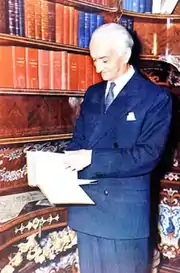
This room was used by the Savoy as a ballroom. Here today are held audiences of the President of the Republic with few participants and the oath of the Judges of the Constitutional Court.
- The Great Hall of Banquets
In the papal era this room was used as the consistory room where the Cardinal's College met. From the Savoy period onwards, banquets and state dinners have been held here. Today, the new government is also sworn in here.
- The Bronzino Room
Here the President of the Republic meets the entourage of visiting foreign dignitaries. The name of the room derives from the tapestries on display, made on Agnolo Bronzino's own design.
- The Druso Room
- The President former audience Room
- The Lilla Tapestries Toom
- The Napoleonic Parlour
- The Piffetti Library
- The Music Room
- The War Room or Victory Room
- The Peace Room
- The Ladies Room
Gardens
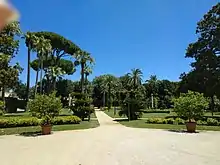
The Quirinal Gardens, famous for the privileged position that makes them almost an "island" elevated above Rome, were over the centuries changed depending on the tastes and needs of the papal court.
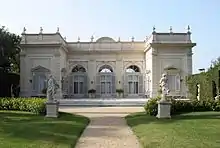
The current arrangement complements the garden "formal" seventeenth century facing the original core of the building with the garden "romantic" in the second half of the eighteenth century, preserving at that time the elegant Coffee House built by Ferdinando Fuga as reception room of Benedict XIV Lambertini, decorated by beautiful paintings of Girolamo Batoni Pompeo and Giovanni Paolo Pannini.
Within the Quirinal gardens lies the famous water organ[6] built between 1997 and 1999 by Barthélemy Formentelli based on the characteristics of the previous nineteenth century organ. The organ is fed by a waterfall with a jump of 18 meters and has a single keyboard of 41 notes with a first short octave, without pedalboard.
Overall, the Quirinal gardens extend over 4 hectares (10 acres).[7]
By means of a trap door located in the gardens, entry can be gained to the archaeological excavations that have unearthed the remains of the original temple to the god Quirinus and some insulae of the imperial age.[8][9][10]
See also
- Palazzo Giustiniani, official residence of the President of the Senate
- Palazzo Madama, seat of the Italian Senate
- Palazzo Montecitorio, seat of the Italian Chamber of Deputies
- Palazzo Chigi, seat of the Italian Government and official residence of the Prime Minister of Italy
- Palazzo della Consulta, seat of the Constitutional Court of Italy
References
- Agence France-Presse, Rome's Quirinal palace - Napoleon's broken dream.
- Quirinale Palace —The Napoleonic Period
- "Il Quirinale, la residenza più vasta del mondo". loveforitaly.it. Retrieved July 18, 2013. Archived from the original on September 27, 2013.
- "I giardini e il Coffee House". quirinale.it Retrieved December 28, 2014.
- "La Manica Lunga e gli Appartamenti Imperiali". quirinale.it. June 2, 2014.
- Fronzuto, pp. 502–504
- Larger, therefore, than those of some comparable buildings, as, for example, the Élysée Palace, with only 1.5 hectares, the Hôtel Matignon, residence of the French prime minister, with 3 hectares, and the grounds of the White House, with 7.3 hectares, all outdone by Buckingham Palace, with its 17 hectares of parkland.
- "I giardini e il Coffee House". quirinale.it. December 28, 2014.
- "La struttura del giardino e le piante". quirinale.it. December 28, 2014.
- "Il Boschetto". quirinale.it. December 28, 2014.
- Rendina, Claudio (1999). Enciclopedia di Roma. Rome: Newton & Compton.
- http://www.nationalgeographic.it/italia/2011/01/02/foto/quirinale_diario_fotografico-157510/1/
- Fronzuto, Graziano (2007). Organi di Roma. Guida pratica orientativa agli organi storici e moderni. Florence. ISBN 978-88-222-5674-4.
External links
| Wikimedia Commons has media related to Quirinal Palace. |
- Official site of Presidency of the Italian Republic
- Virtual tour of Quirinal Palace
- Satellite image of the palace and its garden Note: One block north east of the Gardens is the Palazzo Barberini. Midway along the long southeast wing flanking the garden, across the street, is the small dome of Bernini's Sant'Andrea al Quirinale. At the next corner north is the inconspicuous church by Borromini, San Carlo alle Quattro Fontane. Diagonal and to the west of the facade, amid a warren of small streets is the turquoise tub-like polygon of the Trevi Fountain.